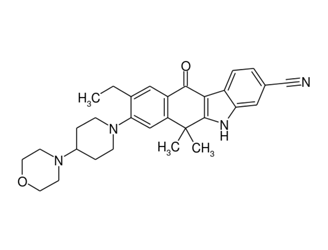Alectinib Promising in ALK-Positive Advanced NSCLC
Alectinib yielded good response rates and was very well tolerated in a phase II trial of patients with advanced, ALK-positive non–small-cell lung cancer.
Chemical structure of alectinib

The ALK and RET inhibitor alectinib yielded good response rates and was very well tolerated in a phase II trial of patients with advanced, ALK-positive non–small-cell lung cancer (NSCLC; abstract 8008). Results were presented at the 2015 American Society of Clinical Oncology (ASCO) Annual Meeting, held May 29 to June 2, in Chicago.
Crizotinib is currently the standard-of-care for advanced, treatment-naive ALK-positive NSCLC. “However, the median progression-free survival (PFS) for these patients on crizotinib is under 12 months,” said Sai-Hong Ignatius Ou, MD, PhD, of the UC Irvine Medical Center in California. “This is in part due to development of ALK mutations that are resistant to crizotinib.”
Alectinib is a next-generation inhibitor that is highly selective for ALK and RET; as an ALK inhibitor, Ou said, it is approximately five times as potent as crizotinib. It can inhibit the majority of clinically relevant acquired ALK mutations.
In the open-label, single-arm, phase II study, 122 patients were evaluable (of 138 in total); they had an average age of 51.6 years, 56% were female, 66% were white, 71% were never-smokers, and 79% had prior chemotherapy.
After a median follow-up of 47 weeks, the trial met its primary endpoint. The overall response rate (ORR) was 49.2%, and the ORR in the prior chemotherapy group (96 patients) was 43.8%. The disease-control rate in the full cohort was 78.7%. Chemo-naive patients did better, Ou said, with a disease control rate of 85%.
Most responders had more than a 50% reduction in their target lesion, and Ou said the response to alectinib was “durable and ongoing,” with a median duration of response of 11.2 months. The median PFS in the trial was 8.9 months.
Notably, the drug achieved a high response rate and disease control rate (83.3%) in patients with central nervous system (CNS) metastases; 75% of those with measurable CNS disease had a reduction in their target lesion.
Most of the adverse events in the trial were grade 1 or 2, with only isolated instances of grade 3/4 events. The most common treatment-related adverse event was myalgia, but Ou said it was “mostly transient.” Only 8.7% of the cohort needed a dose-reduction as a result of adverse events.
Ou said there is an ongoing phase III trial directly comparing alectinib to crizotinib. Alex A. Adjei, MD, PhD, of Roswell Park Cancer Institute in Buffalo, New York, was the discussant for the session, and said that direct comparisons will be important.
“We have this luxury of three agents that are going to be approved; alectinib is already approved in Japan,” Adjei said. A trial comparing alectinib to the other two options, crizotinib and ceritinib, in ALK-positive NSCLC is forthcoming, he said.